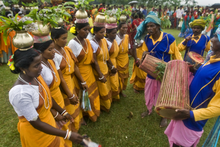Santali people

Santali people at a dance
|
|
| Total population | |
|---|---|
| 6,850,000–6,950,000 | |
| Regions with significant populations | |
| Jharkhand | 2,410,509 |
| West Bengal | 2,280,540 |
| Bihar | 367,612 |
| Odisha | 629,782 |
| Nepal |
42,698 |
| Jhapa District | 23,172 |
| Morang District | 16,387 |
| Assam | 800,000-900,000 |
| Bangladesh | 271,485 (in 2012) |
| Languages | |
| Santali | |
| Religion | |
| Sari Dharam • Sarnaism • Hinduism • Christianity | |
| Related ethnic groups | |
| Mundas • Hos • Kols • other Mon-Khmer people | |
42,698
The Santal or Saontal (also spelled as Santal,Sontal or Sonthal), are a scheduled tribe of people indigenous to Terai of Nepal and India, who live mainly in Nepal and the Indian States of Jharkhand, West Bengal, Bihar, Odisha, Assam (part of the Tea Tribes). There is also a significant Santhal minority in neighboring Bangladesh, and a small population in Nepal (known as Satar in Nepal). They are one of the largest tribal communities in India. The Santals mostly speak Santali, a member of the Munda language family.
The Reverend J. Phillips published 'An Introduction to the Santal Language' in 1852, printed at the Calcutta School – Book Society's Press.
Lars Olsen Skrefsrud, a Norwegian missionary and a language researcher, published 'A Grammar of Santali Language' in 1873.
Paul Olaf Bodding (born Gjøvik, Norway on 2 November 1865, died Odense, Denmark on 25 September 1938) was a Norwegian missionary, linguist and folklorist. He served in India for 44 years (1889–1933), and operated mainly from the town Dumka in the Santal Parganas-district. Bodding created the first alphabet and wrote the first grammar for the Santali-speaking native people in eastern India. In 1914 he also completed the translation of the Bible into the Santali Language.
In about 1925 Raghunath Murmu created Ol Chiki script for the Santali Language.
One of the most studied tribal religions in India, the Santal religion worships Marang buru, or Bonga, as the Supreme Deity. The weight of belief, however, falls on a court of spirits (Bonga), who handle different aspects of the world and who are placated with prayers and offerings in order to ward off evil influences. These spirits operate at the village, household, ancestor, and sub-clan level, along with evil spirits that cause disease and can inhabit village boundaries, mountains, water, tigers, and the forest. A characteristic feature of the Santal village is a sacred grove (known as the Jaher or "Santal Sthal") on the edge of the settlement where many spirits live and where a series of annual festivals take place.
...
Wikipedia
